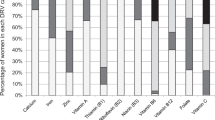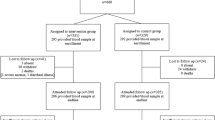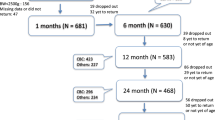Abstract
Objective: To determine the vitamin D status of a sample of young Asian children living in England by measurement of plasma 25-hydroxycholecalciferol levels; to relate biochemical measurements with parameters of diet, lifestyle and iron status in this population.
Design: The ‘Infant Feeding in Asian Families’ survey covered infants born to mothers of Bangladeshi, Indian or Pakistani origin, plus a sample of children born to White mothers in 41 local authority areas. The current study describes vitamin D values in a sub sample of Asian children from that survey.
Setting: Forty-one local authority areas which covered 95% of the Asian population at the time of the 1991 Census and include areas with the highest and lowest density of Asians.
Subjects: Seventy-one percent (2382) of mothers who were originally eligible were interviewed on four occasions up to the time their infant was 15 months. One thousand, seven hundred and thirty-eight of these children were followed up for this current study. Of these 618 had a blood sample analysed for vitamin D.
Outcome measures: Previous day’s food intake, normal dietary intake, indicators of iron status and plasma vitamin D levels.
Results: Plasma vitamin D values are lower in the three groups of Asian children than values reported for children of a similar age in the National Diet and Nutrition Survey. Between one third and a half of children with a low haemoglobin also had low plasma vitamin D values; there was a significant association between failure to take a vitamin supplement, chapati consumption and low vitamin D values.
Conclusions: It is particularly important that pre-school Asian children receive a vitamin D supplement. Children with low haemoglobin values should be screened for vitamin D deficiency.
Sponsorship: The study was funded by the Department of Health.
This is a preview of subscription content, access via your institution
Access options
Subscribe to this journal
Receive 12 print issues and online access
$259.00 per year
only $21.58 per issue
Buy this article
- Purchase on Springer Link
- Instant access to full article PDF
Prices may be subject to local taxes which are calculated during checkout
Similar content being viewed by others
Author information
Authors and Affiliations
Rights and permissions
About this article
Cite this article
Lawson, M., Thomas, M. & Hardiman, A. Dietary and lifestyle factors affecting plasma vitamin D levels in Asian children living in England. Eur J Clin Nutr 53, 268–272 (1999). https://doi.org/10.1038/sj.ejcn.1600717
Received:
Revised:
Accepted:
Published:
Issue Date:
DOI: https://doi.org/10.1038/sj.ejcn.1600717



